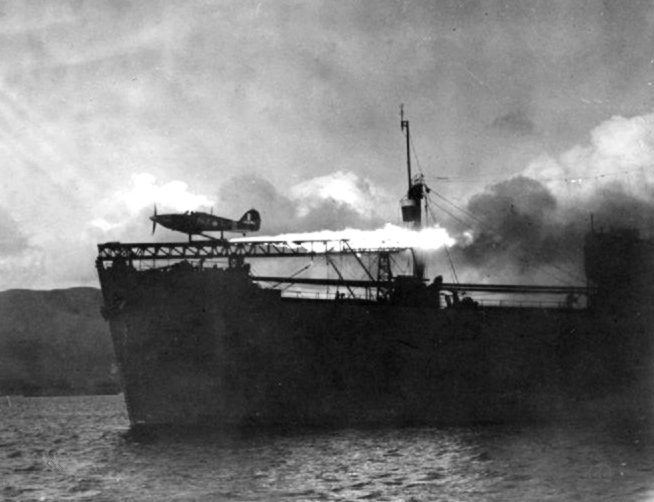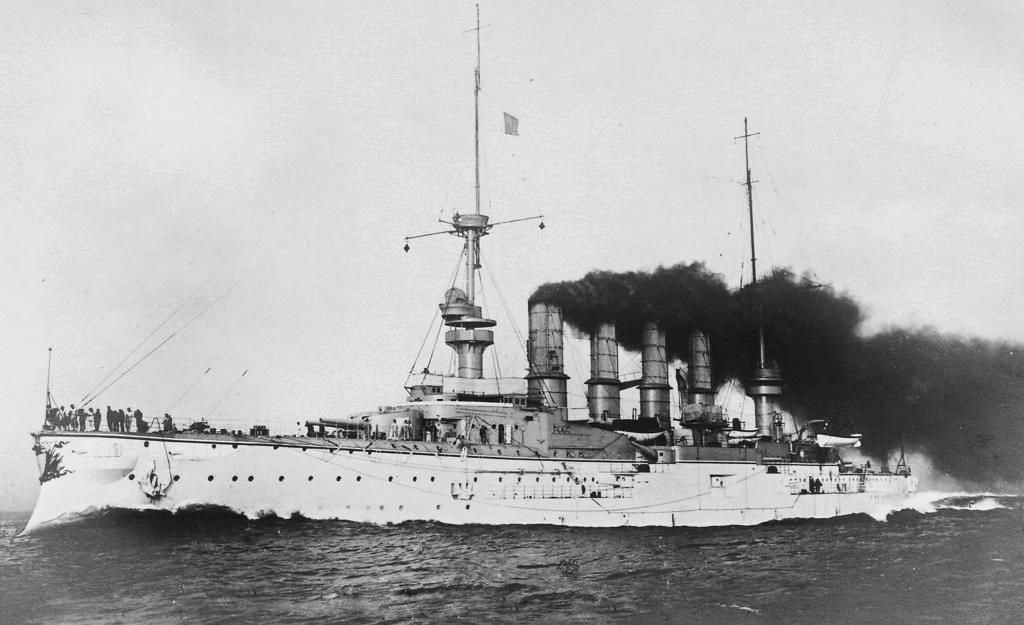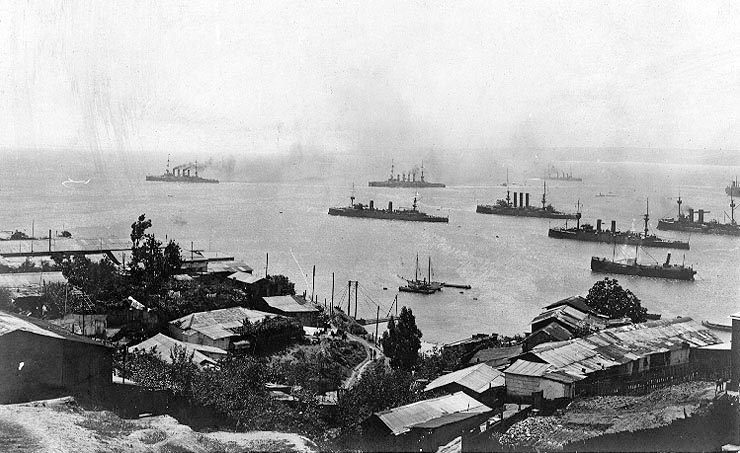|
German Pocket Battleship Admiral Graf Spee
was a (armored ship), nicknamed a "pocket battleship" by the British, which served with the of Nazi Germany during World War II. The vessel was named after World War I Admiral Maximilian von Spee, commander of the East Asia Squadron who fought the battles of Coronel and the Falkland Islands, where he was killed in action. She was laid down at the shipyard in Wilhelmshaven in October 1932 and completed by January 1936. The ship was nominally under the limitation on warship size imposed by the Treaty of Versailles, though with a full load displacement of , she significantly exceeded it. Armed with six guns in two triple gun turrets, and her sisters were designed to outgun any cruiser fast enough to catch them. Their top speed of left only a few capital ships in the Anglo-French navies fast enough and powerful enough to sink them. The ship conducted five non-intervention patrols during the Spanish Civil War in 1936–1938 and participated in the Coronation Review of ... [...More Info...] [...Related Items...] OR: [Wikipedia] [Google] [Baidu] |
Nazi Germany
Nazi Germany, officially known as the German Reich and later the Greater German Reich, was the German Reich, German state between 1933 and 1945, when Adolf Hitler and the Nazi Party controlled the country, transforming it into a Totalitarianism, totalitarian dictatorship. The Third Reich, meaning "Third Realm" or "Third Empire", referred to the Nazi claim that Nazi Germany was the successor to the earlier Holy Roman Empire (800–1806) and German Empire (1871–1918). The Third Reich, which the Nazis referred to as the Thousand-Year Reich, ended in May 1945, after 12 years, when the Allies of World War II, Allies defeated Germany and entered the capital, Berlin, End of World War II in Europe, ending World War II in Europe. After Hitler was appointed Chancellor of Germany in 1933, the Nazi Party began to eliminate political opposition and consolidate power. A 1934 German referendum confirmed Hitler as sole ''Führer'' (leader). Power was centralised in Hitler's person, an ... [...More Info...] [...Related Items...] OR: [Wikipedia] [Google] [Baidu] |
Aircraft Catapult
An aircraft catapult is a device used to help fixed-wing aircraft gain enough airspeed and lift for takeoff from a limited distance, typically from the deck of a ship. They are usually used on aircraft carrier flight decks as a form of assisted takeoff, but can also be installed on land-based runways, although this is rare. The catapult used on aircraft carriers consists of a track or slot built into the flight deck, below which is a large piston or ''shuttle'' that is attached through the track to the nose gear of the aircraft, or in some cases a wire rope, called a catapult bridle, is attached to the aircraft and the catapult shuttle. Other forms have been used historically, such as mounting a launching cart holding a seaplane on a long girder-built structure mounted on the deck of a warship or merchant ship, but most catapults share a similar sliding track concept. Different means have been used to propel the catapult, such as weight and derrick, gunpowder, flywheel, co ... [...More Info...] [...Related Items...] OR: [Wikipedia] [Google] [Baidu] |
Spanish Civil War
The Spanish Civil War () was a military conflict fought from 1936 to 1939 between the Republican faction (Spanish Civil War), Republicans and the Nationalist faction (Spanish Civil War), Nationalists. Republicans were loyal to the Left-wing politics, left-leaning Popular Front (Spain), Popular Front government of the Second Spanish Republic. The opposing Nationalists were an alliance of Falangism, Falangists, monarchists, conservatives, and Traditionalism (Spain), traditionalists led by a National Defense Junta, military junta among whom General Francisco Franco quickly achieved a preponderant role. Due to the international Interwar period#Great Depression, political climate at the time, the war was variously viewed as class struggle, a War of religion, religious struggle, or a struggle between dictatorship and Republicanism, republican democracy, between revolution and counterrevolution, or between fascism and communism. The Nationalists won the war, which ended in early 1939, ... [...More Info...] [...Related Items...] OR: [Wikipedia] [Google] [Baidu] |
Non-intervention In The Spanish Civil War
During the Spanish Civil War, most European countries followed a policy of non-intervention to avoid potential escalation or expansion of the war to other states. This policy led to the signing of the Non-Intervention Agreement in August 1936 and the setting up of the Non-Intervention Committee, which first met in September. Primarily arranged by the French Third Republic, French and United Kingdom, British governments, the committee included the Soviet Union, Fascist Italy (1922–1943), Fascist Italy, and Nazi Germany. Ultimately, the committee had the support of 27 states. A plan to control materials coming into Spain was put forward in early 1937, effectively subjecting the Second Spanish Republic, Spanish Republic to severe international isolation and a ''de facto'' trade embargo, economic embargo. The plan was mocked by German and Italian observers as amounting to immediate and decisive support for the Nationalist faction (Spanish Civil War), Spanish Nationalist faction. Th ... [...More Info...] [...Related Items...] OR: [Wikipedia] [Google] [Baidu] |
Capital Ship
The capital ships of a navy are its most important warships; they are generally the larger ships when compared to other warships in their respective fleet. A capital ship is generally a leading or a primary ship in a naval fleet. Strategic implications There is usually no formal criterion for the classification, but it is a useful concept in naval strategy; for example, it permits comparisons between relative naval strengths in a theatre of operations without the need for considering specific details of tonnage or gun diameters. A notable example of this is the Alfred Thayer Mahan, Mahanian doctrine, which was applied in the Sinking of Prince of Wales and Repulse, planning of the defence of Singapore in World War II, where the Royal Navy had to decide the allocation of its battleships and battlecruisers between the Atlantic and Pacific theatres. The Mahanian doctrine was also applied by the Imperial Japanese Navy, leading to its Preventive war, preventive move to Attack on P ... [...More Info...] [...Related Items...] OR: [Wikipedia] [Google] [Baidu] |
Cruiser
A cruiser is a type of warship. Modern cruisers are generally the largest ships in a fleet after aircraft carriers and amphibious assault ships, and can usually perform several operational roles from search-and-destroy to ocean escort to sea denial. The term "cruiser", which has been in use for several hundred years, has changed its meaning over time. During the Age of Sail, the term ''cruising'' referred to certain kinds of missions—independent scouting, commerce protection, or raiding—usually fulfilled by frigates or sloop-of-war, sloops-of-war, which functioned as the ''cruising warships'' of a fleet. In the middle of the 19th century, ''cruiser'' came to be a classification of the ships intended for cruising distant waters, for commerce raiding, and for scouting for the battle fleet. Cruisers came in a wide variety of sizes, from the medium-sized protected cruiser to large armored cruisers that were nearly as big (although not as powerful or as well-armored) as a pre- ... [...More Info...] [...Related Items...] OR: [Wikipedia] [Google] [Baidu] |
Full-load Displacement
The displacement or displacement tonnage of a ship is its weight. As the term indicates, it is measured indirectly, using Archimedes' principle, by first calculating the volume of water displaced by the ship, then converting that value into weight. Traditionally, various measurement rules have been in use, giving various measures in long tons. Today, tonnes are more commonly used. Ship displacement varies by a vessel's degree of load, from its empty weight as designed (known as "lightweight tonnage") to its maximum load. Numerous specific terms are used to describe varying levels of load and trim, detailed below. Ship displacement should not be confused with measurements of volume or capacity typically used for commercial vessels and measured by tonnage: net tonnage and gross tonnage. Calculation The process of determining a vessel's displacement begins with measuring its draft.George, 2005. p. 5. This is accomplished by means of its "draft marks". A merchant vessel has three ... [...More Info...] [...Related Items...] OR: [Wikipedia] [Google] [Baidu] |
Treaty Of Versailles
The Treaty of Versailles was a peace treaty signed on 28 June 1919. As the most important treaty of World War I, it ended the state of war between Germany and most of the Allies of World War I, Allied Powers. It was signed in the Palace of Versailles, exactly five years after the assassination of Archduke Franz Ferdinand, which led to the war. The other Central Powers on the German side signed separate treaties. Although the Armistice with Germany (Compiègne), armistice of 11 November 1918 ended the actual fighting, and agreed certain principles and conditions including the payment of reparations, it took six months of Allied negotiations at the Paris Peace Conference (1919–1920), Paris Peace Conference to conclude the peace treaty. Germany was not allowed to participate in the negotiations before signing the treaty. The treaty German disarmament, required Germany to disarm, make territorial concessions, extradite alleged war criminals, agree to Kaiser Wilhelm being p ... [...More Info...] [...Related Items...] OR: [Wikipedia] [Google] [Baidu] |
Keel Laying
Laying the keel or laying down is the formal recognition of the start of a shipbuilding, ship's construction. It is often marked with a ceremony attended by dignitaries from the shipbuilding company and the ultimate owners of the ship. Keel laying is one of the four specially celebrated events in a ship's life; the others are Ceremonial ship launching, launching, Ship commissioning, commissioning, and Ship decommissioning, decommissioning. Earlier, the event recognized as the keel laying was the initial placement of the central timber making up the backbone of a vessel, called the keel. As steel ships replaced wooden ones, the central timber gave way to a central steel beam. Modern ships are most commonly built in a series of pre-fabricated, complete hull sections rather than around a single keel. The event recognized as the keel laying is the first joining of modular components, or the lowering of the first module into place in the building dock. It is now often called "keel ... [...More Info...] [...Related Items...] OR: [Wikipedia] [Google] [Baidu] |
Battle Of The Falkland Islands
The Battle of the Falkland Islands was a First World War naval action between the British Royal Navy and Imperial German Navy on 8 December 1914 in the South Atlantic. The British, after their defeat at the Battle of Coronel on 1 November, sent a large force to track down and destroy the German cruiser squadron. The battle is commemorated every year on 8 December in the Falkland Islands as a public holiday. Admiral Graf Maximilian von Spee commanding the German squadron of two armoured cruisers, and , the light cruisers , and , and the colliers SS ''Baden'', SS ''Santa Isabel'', and SS ''Seydlitz''Battle of the Falkland Islands -names the three German auxiliary ships and states that ''Bristol'' and ''Macedonia'' sank the colliers ''Baden'' and ''Santa Isabel'', while 'the other collier', ''Seydlitz'', escaped.- ''www.wo ... [...More Info...] [...Related Items...] OR: [Wikipedia] [Google] [Baidu] |
Battle Of Coronel
The Battle of Coronel was a First World War naval battle that led to an Imperial German Navy victory over the Royal Navy on 1 November 1914, off the coast of central Chile near the city of Coronel. The East Asia Squadron (''Ostasiengeschwader'' or ''Kreuzergeschwader'') of the Imperial German Navy (''Kaiserliche Marine'') led by Vice-Admiral Graf Maximilian von Spee met and overpowered a British squadron commanded by Rear-Admiral Sir Christopher Cradock. The engagement probably took place as a result of misunderstandings. Neither admiral expected to meet the other in full force. Once the two met, Cradock understood his orders were to fight to the end, despite the odds being heavily against him. Although Spee had an easy victory, destroying two enemy armoured cruisers for just three men injured, the engagement also cost him almost half his supply of ammunition, which was irreplaceable. Shock at the British losses led the Admiralty to send more ships, including two modern ba ... [...More Info...] [...Related Items...] OR: [Wikipedia] [Google] [Baidu] |
East Asia Squadron
The German East Asia Squadron () was an Imperial German Navy cruiser squadron which operated mainly in the Pacific Ocean between the mid-1890s until 1914, when it was destroyed at the Battle of the Falkland Islands. It was based at Germany's Jiaozhou Bay Leased Territory in China. Background The Treaty of Peking of September 1861 between the Kingdom of Prussia and China allowed Prussian warships to operate in Chinese waters. As East Asia grew in economic and political importance to the recently united Germany, in 1881, a flying squadron was formed for the area under the command of a flag officer. Since African colonies were then seen as of greater value, an African Cruiser Squadron was established in 1885 with permanent status, and shortly thereafter the Imperial German Navy reduced the East Asia presence to two small gunboats. From 1888 to 1892, was flagship of the German East Asia Squadron, initially under Vice Admiral Karl August Deinhardt, appointed 14 July when the ship w ... [...More Info...] [...Related Items...] OR: [Wikipedia] [Google] [Baidu] |










